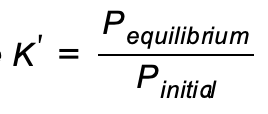a) Calculate the Gibbs energy change of the reaction (AG) at 25°C. b) Is the reaction exothermic or endothermic at 25°C? c) A constant volume reactor is initially loaded with an equimolar mixture of A, B and C at 12 bar. The reaction is allowed to take place at constant temperature (T) and when equilibrium is reached, the pressure in the reactor is 15 bar. Unfortunately due to a malfunction in the thermometer, the actual temperature is not known. What is the temperature of the reactor?
a) Calculate the Gibbs energy change of the reaction (AG) at 25°C. b) Is the reaction exothermic or endothermic at 25°C? c) A constant volume reactor is initially loaded with an equimolar mixture of A, B and C at 12 bar. The reaction is allowed to take place at constant temperature (T) and when equilibrium is reached, the pressure in the reactor is 15 bar. Unfortunately due to a malfunction in the thermometer, the actual temperature is not known. What is the temperature of the reactor?
Chemistry
10th Edition
ISBN:9781305957404
Author:Steven S. Zumdahl, Susan A. Zumdahl, Donald J. DeCoste
Publisher:Steven S. Zumdahl, Susan A. Zumdahl, Donald J. DeCoste
Chapter1: Chemical Foundations
Section: Chapter Questions
Problem 1RQ: Define and explain the differences between the following terms. a. law and theory b. theory and...
Related questions
Question

Transcribed Image Text:The equilibrium constant of the gas-phase reaction,
2A(g) + 3B (g) → 2C(g)
is experimentally found to be, K = ae/r, with a = 10-5 and b = 1200 K.
a) Calculate the Gibbs energy change of the reaction (AG) at 25°C.
b) Is the reaction exothermic or endothermic at 25°C?
c) A constant volume reactor is initially loaded with an equimolar mixture of A, B
and C at 12 bar. The reaction is allowed to take place at constant temperature
(T) and when equilibrium is reached, the pressure in the reactor is 15 bar.
Unfortunately due to a malfunction in the thermometer, the actual temperature
is not known. What is the temperature of the reactor?
Additional data: Assume ideal gas mixture.
Expert Solution
This question has been solved!
Explore an expertly crafted, step-by-step solution for a thorough understanding of key concepts.
Step 1: Given data
VIEWStep 2: a. Calculation of Gibbs Free Energy Change
VIEWStep 3: b. Predicting the nature of the reaction.
VIEWStep 4: c. Determination of the temperature-Construction of ICE table.
VIEWStep 5: c. Determination of the temperature-Solving the ICE table
VIEWStep 6: c. Determination of the temperature-Calculation of equilibrium constant
VIEWStep 7: c. Determination of the temperature
VIEWSolution
VIEWStep by step
Solved in 8 steps with 14 images

Follow-up Questions
Read through expert solutions to related follow-up questions below.
Follow-up Question
can you explain this equation i dont quite get where u get this from

Transcribed Image Text:-K'
=
P
equilibrium
Pinitial
Solution
Knowledge Booster
Learn more about
Need a deep-dive on the concept behind this application? Look no further. Learn more about this topic, chemistry and related others by exploring similar questions and additional content below.Recommended textbooks for you

Chemistry
Chemistry
ISBN:
9781305957404
Author:
Steven S. Zumdahl, Susan A. Zumdahl, Donald J. DeCoste
Publisher:
Cengage Learning

Chemistry
Chemistry
ISBN:
9781259911156
Author:
Raymond Chang Dr., Jason Overby Professor
Publisher:
McGraw-Hill Education

Principles of Instrumental Analysis
Chemistry
ISBN:
9781305577213
Author:
Douglas A. Skoog, F. James Holler, Stanley R. Crouch
Publisher:
Cengage Learning

Chemistry
Chemistry
ISBN:
9781305957404
Author:
Steven S. Zumdahl, Susan A. Zumdahl, Donald J. DeCoste
Publisher:
Cengage Learning

Chemistry
Chemistry
ISBN:
9781259911156
Author:
Raymond Chang Dr., Jason Overby Professor
Publisher:
McGraw-Hill Education

Principles of Instrumental Analysis
Chemistry
ISBN:
9781305577213
Author:
Douglas A. Skoog, F. James Holler, Stanley R. Crouch
Publisher:
Cengage Learning

Organic Chemistry
Chemistry
ISBN:
9780078021558
Author:
Janice Gorzynski Smith Dr.
Publisher:
McGraw-Hill Education

Chemistry: Principles and Reactions
Chemistry
ISBN:
9781305079373
Author:
William L. Masterton, Cecile N. Hurley
Publisher:
Cengage Learning

Elementary Principles of Chemical Processes, Bind…
Chemistry
ISBN:
9781118431221
Author:
Richard M. Felder, Ronald W. Rousseau, Lisa G. Bullard
Publisher:
WILEY